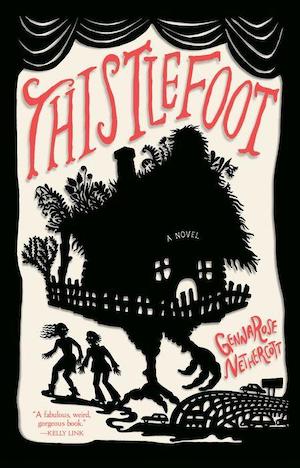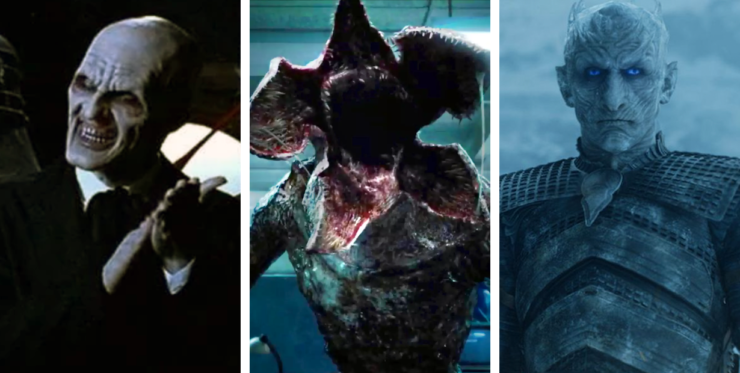I truly believe that nothing beats a good TV monster. Ever since I found religion (ie, Buffy the Vampire Slayer) at age eleven, I haven’t been able to get enough of ‘em. And now, as a fantasy writer and folklorist, I think I know why: Monsters are mirrors. They’re reflections of what we fear, what we question, what we loathe and long for. Every monster contains a contradiction: zombies are living and dead. Werewolves are animal and human. Vampires are enticing yet deadly. And in that dissonance, we find all the contradictions and complexities within ourselves. What’s more enticing than that?
But these creatures weren’t born in writers’ rooms—they sprung to life organically, in the mouths of folktale tellers throughout time. Some of our favorite TV creepy crawlies have roots stretching back far before the small screen was even invented. Here are five TV monsters you know and love—and the real folklore behind them.
The Twilight Zone’s “Nightmare at 20,000 Feet” Gremlin vs WWII Gremlins
Often named as The Twilight Zone’s finest episode, “Nightmare at 20,000 Feet” stars a young William Shatner as Bob Wilson—a man trapped on the deadliest flight of his life. The titular nightmare in question? A furry, gorilla-like monster crouching on the airplane’s wing, which begins tampering with the engine. Poor Bob stares out the window in horror.
This isn’t your “don’t feed it after midnight” 1984 variety of gremlin. The Twilight Zone was, in fact, referencing a real legend—that originated in the early days of aviation, particularly among British WWII pilots.
As early as 1917, British pilots had begun whispering of “mysterious and malicious spirits” who sought to cause mechanical mischief. In 1923, one British pilot survived a plane crash into the sea after his engine mysteriously stalled mid-air. When recounting what happened, he claimed to have seen tiny creatures on the plane, tampering with the mechanics, and called them by name: gremlins. By WWII, this pilot’s story—and the many similar tales that followed—were ubiquitous among R.A.F. fighter pilots. Anything from faulty machinery to cut wires was quickly blamed on the pesky airplane gremlins.
Whether gremlins were real or not, they just may have helped the Allies win the war. Mechanical failures that otherwise might have led to finger pointing and blame throwing between R.A.F. pilots was saddled onto gremlins, instead. In other words: a fantastical scapegoat. By lobbing accusations at a gremlin, rather than members of their own squadron, morale stayed up—and so did the planes.
Game of Thrones’ White Walkers vs Draugr
Primarily called “the Others” in the books, the chilling White Walkers are the greatest supernatural threat to Westeros and beyond—and some of Game of Thrones’ most iconic figures. And while you might be resting easy in the knowledge that these icy, demonic beings aren’t real… ancient Scandinavians didn’t have that luxury.
Viking-era Scandinavians believed in a being called the draugr: an animated corpse with—get this—blue skin and glowing blue eyes. While the noblest Vikings ascended to Valhalla after death, others weren’t so lucky—and instead, their bodies would re-awaken with a terrible new life. Like the White Walkers’ undead army of wights, draugr were corporeal ghosts (similar to a zombie), prone to escaping their tombs and wreaking havoc on nearby towns. Draugr were also known to possess knowledge of the future, enter humans’ dreams, control the weather, and even shape shift. And just as White Walkers could only be killed with specific weapons (dragonglass or Valyrian steel) draugr had to be decapitated with a blade from their own collection.
To the Vikings, this was no mere bedtime story. They took active, preventative measures to make sure their dead wouldn’t become draugr after burial. In some cases, large stones were placed atop graves to hold the bodies in. And while it was customary to bury Viking warriors with their weapons, some of these weapons would be rendered useless, just in case whoever was there in the coffin…woke up. After all, the only thing worse than a supernatural, frozen ghost is a supernatural, frozen ghost with a sword.
Stranger Things’ Demogorgon vs 5th Century Demogorgon
While the kids of Hawkins named their toothy, flower-faced nemesis after a monster in Dungeons & Dragons, the term “demogorgon” far pre-dates the tabletop role playing game. In fact, it’s been popping up in literature since the 5th century.
In the Middle Ages, Christian writers portrayed the creature as an ancient, all-powerful demon. In 1590, Christopher Marlow’s Doctor Faustus invokes the demogorgon’s name to summon a demon of hell, and in the 1600s, it appears in John Milton’s Paradise Lost. Edmund Spenser’s poem The Faerie Queen calls the demogorgon a “prince of darkness and dead night,” while in 1820, romantic poet Percy Bysshe Shelley wrote of the demogorgon as a limbless, formless “mighty darkness” who overthrows Jupiter, king of the Gods, before “filling the seat of power.” Even Moby-Dick’s great white whale is, at one point, referred to as a “demigorgon.”
But where did all these legendary writers learn about the demogorgon? Well, turns out, it may be from a 2,000 year old typo. The first written mention of the demogorgon was penned by scholar Lactantius Placidus—in a commentary on Roman poet Statius epic Thebaid. Lactantius Pacidus wrote “He is speaking of the Demogorgon, the supreme god, whose name it is not permitted to know.” But hey, even 5th century scholars make mistakes… It’s now believed that Lactanius Placidus simply misspelled the Greek “demiurge” which meant “a being responsible for the creation of the universe.”
And because later, in the Early Modern Period (c. 1450 – c. 1750), it was common for Christian writers to rebrand early deities as demons—the once-holy demogorgon/demiurge got a makeover as a prince of hell.
So uh… things in Hawkins might be more dire than we thought. Because it looks like the demogorgon isn’t a monster at all. It’s a god.
Buffy the Vampire Slayer’s The Gentlemen vs Grimm’s Fairytales and the Voice-Stealing Iele
“Can’t even shout, can’t even cry. The Gentlemen are coming by. Looking in windows, knocking on doors, they need to take seven and they might take yours…”
Of all the bumpy, slithering, flesh-flaying, blood sucking Monsters of the Week Buffy gifted us—none are more infamous than the Gentlemen. Tall, pale humanoids in fitted black suits smacking with pallbearers chic, these heart-snatching demons sport sharp scalpels and even sharper grins. But their most famed feature? Their silence—and, well, yours. Not only are the Gentlemen entirely mute, but they can steal the voices from an entire town, leaving its residents unable to cry out for help.
In “Hush” (the fan-fave episode in question), the Gentlemen are said to hail from the realm of fairy tales. Now, while the actual Gentlemen were invented for the show, there are many fairytales featuring muteness: Hans Christian Andersen’s The Little Mermaid, of course, where a mermaid relinquishes her voice in exchange for human legs; Grimm’s The Six Swans, in which a princess vows six years of silence to save her cursed brothers; another similar German tale, The Twelve Brothers, in which a princess doesn’t speak or laugh for seven years to save her brothers. The trope of the “voiceless female hero saving the day” pops up again and again—so when Buffy Summers, the slayer herself, manages to rescue Sunnydale without uttering a word, she becomes one more champion in a long lineage of silent heroines.
But enough about the heroes. What about voice-stealing monsters?
The Iele of Romanian folklore might be just the ticket. Similar to Greek Nymphs and Dryads, the Iele are mythical fairy-like women who spend their time bathing by moonlight, or dancing in circles with such intensity that they leave scorched earth beneath their feet. They hold immense alluring power—and like Sirens, have mesmerizing voices that can lure men to their doom. However, their enchanting songs go one step further: whoever hears an Iele’s song is rendered immediately and entirely mute.
Dune’s Sandworms vs Mongolian Death Worms
You know sandworms? Sure you do. Giant, spicy, orange death tubes rocketing through the vast desert, gobbling up anyone brash enough to encroach on their territory. But what you might not have known is that sandworms aren’t confined to the planet Arrakis. They’re also…in Mongolia.
Mongolian folklore speaks of a creature called “Olgoi-Khorkhoi” also known as the Mongolian Death Worm. Like Dune’s sandworms, they’re also reddish, tube-shaped worm monsters that slink beneath the sands—in this case, through the Gobi desert. The good news: they’re much smaller than sandworms, reaching only two-to-seven feet in length (Basically, they look like a murderous wriggling intestine. I’m sorry.). The bad news: they’re covered in lethal, acidic venom so potent that merely a touch will kill you. In some legends, the Death Worm is said to raise its body up from the sand and inflate itself until it explodes—spewing venom toward victims in all directions. Charming.
Oh, and if this all reminds you of another classic, the movie Tremors (1990)—that’s because Tremors’ Graboids were likely based on the Olgoi-Khorkhoi.
Well, five monsters hunted down…only a million still out there, lurking. What are your favorite creatures from folklore and fiction? Leave them growling and snapping in the comments!
Buy the Book


Thistlefoot
Gennarose Nethercott is a writer and folklorist. Her first book, The Lumberjack’s Dove, was selected by Louise Glück as a winner of the National Poetry Series, and whether authoring novels, poems, ballads, or even fold-up paper cootie catchers, her projects are all rooted in myth—and what our stories reveal about who we are. She tours nationally and internationally performing strange tales (sometimes with puppets in tow) and composing poems-to-order for strangers on an antique typewriter with her team, the Traveling Poetry Emporium. She lives in the woodlands of Vermont, beside an old cemetery. Thistlefoot is her debut novel.










